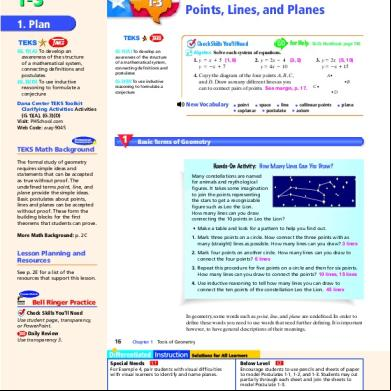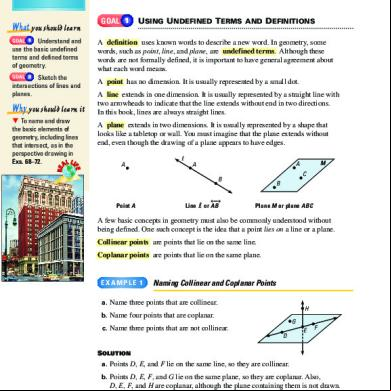Invariant Points And Lines 3jy5m
This document was ed by and they confirmed that they have the permission to share it. If you are author or own the copyright of this book, please report to us by using this report form. Report 3i3n4
Overview 26281t
& View Invariant Points And Lines as PDF for free.
More details 6y5l6z
- Words: 954
- Pages: 10
Invariant points and lines
Invariant points An invariant point is a point that is unchanged by a transformation. Which points remain unchanged in the reflection y=x? How about in a rotation of 450 about (3,2)?
Invariant lines Invariant lines are lines where points map back onto themselves (line of invariant points). It can also be a line where the points map back onto a (usually) different place on the line.
It can be seen that in the reflection y = x, there are an infinite number of invariant lines, y = -x + c
Eigenvector approach We were able to find lines of invariant points (eval=1) and invariant lines by using the eigenvalue-eigenvector approach. However, this method has limitations.. 1. We can only easily find invariant lines that through the origin. 2.
It is impossible to know if the invariant line you have found is unique or if there are more in its family.
An alternative approach
4 -1� �
Example: Find the invariant points and lines of the transformation T = � 2 5� � � The invariant points must satisfy the following equation.. x 4 -1��� x �� � = �� � �� y 2 5� y �� � ���
We can the obtain the following simultaneous equations
x = 4x - y y = 2x + 5 y y = 3x y = -0.5 x
From 1st equation
x = 0, y = 0 (0, 0)
x and y must both be 0
From 2nd equation The origin is the only invariant point
4 -1� �
Example: Find the invariant points and lines of the transformation T = � 2 5� � � The equation for our invariant line is of the form y=mx+c
x '� � 4 -1��� x � =� � � ��� y ' 2 5 y �� � ���
This time the points don’t map onto themselves
x '� � 4 -1�� x � � =� � � �� � We can replace y with mx+c y ' 2 5 mx + c �� � �� �
x ' = 4 x - (mx + c) Write as simultaneous equations x ' = 4 x - mx - c y ' = 2 x + 5(mx + c) y ' = 2 x + 5mx + 5c y ' = mx '+ c We know that invariant lines are of the form.. 2 x + 5mx + 5c = m(4 x - mx - c) + c 2 x + 5mx + 5c = 4mx - m 2 x - mc + c m 2 x + mx + 2 x = -mc - 4c x(m 2 + m + 2) = -c(m + 4)
Substitute and simplify…
Rearrange so x’s together and c’s together
4 -1� �
Example: Find the invariant points and lines of the transformation T = � 2 5� � � 2
x(m + m + 2) + c(m + 4) = 0
In order for the above to work, we need
m2 + m + 2 = 0 As
and
c(m + 4) = 0
m 2 + m + 2 = 0 has no real roots, we deduce that there is no invariant line.
10 -6 � � -6 5 � � �
Example: Find the invariant points and lines of the transformation T = � The invariant points must satisfy the following equation.. x 10 -6 ��� x �� � = �� � �� y -6 5 � y �� � ���
We can the obtain the following simultaneous equations
x = 10 x - 6 y y = -6 x + 5 y 3 y= x 2 3 y= x 2
From 1st equation From 2nd equation
Both give same equations so must be a line of invariant points.
10 -6 � � -6 5 � � �
Example: Find the invariant points and lines of the transformation T = � The equation for our invariant line is of the form y=mx+c
x '� � 10 -6 ��� x � =� � � ��� y ' 6 5 y �� � ���
This time the points don’t map onto themselves
x '� � 10 -6�� x � � =� � � �� � We can replace y with mx+c y ' 6 5 mx + c �� � �� �
x ' = 10 x - 6(mx + c) Write as simultaneous equations x ' = 10 x - 6mx - 6c y ' = -6 x + 5(mx + c) y ' = -6 x + 5mx + 5c y ' = mx '+ c We know that invariant lines are of the form.. -6 x + 5mx + 5c = m(10 x - 6mx - 6c) + c Substitute and simplify… -6 x + 5mx + 5c = 10mx - 6m 2 x - 6mc + c 6m 2 x - 5mx - 6 x = -6mc - 4c x(6m 2 - 5m - 6) = -2c(3m + 2)
Rearrange so x’s together and c’s together
-6 � -6 5 � � � 10
Example: Find the invariant points and lines of the transformation T = � �
x(6m 2 - 5m - 6) = -2c(3m + 2) In order for the above to work, we need
6m 2 - 5m - 6 = 0
and
-2c(3m + 2) = 0
(2m - 3)(3m + 2) = 0 m=
3 2
2 m=3
c=0 2 m=3
3 3 c = 0 When m = , which means y = x is invariant 2 2 2 2 When m = - , c is arbitrary which means y = - x + c is invariant 3 3
Invariant points An invariant point is a point that is unchanged by a transformation. Which points remain unchanged in the reflection y=x? How about in a rotation of 450 about (3,2)?
Invariant lines Invariant lines are lines where points map back onto themselves (line of invariant points). It can also be a line where the points map back onto a (usually) different place on the line.
It can be seen that in the reflection y = x, there are an infinite number of invariant lines, y = -x + c
Eigenvector approach We were able to find lines of invariant points (eval=1) and invariant lines by using the eigenvalue-eigenvector approach. However, this method has limitations.. 1. We can only easily find invariant lines that through the origin. 2.
It is impossible to know if the invariant line you have found is unique or if there are more in its family.
An alternative approach
4 -1� �
Example: Find the invariant points and lines of the transformation T = � 2 5� � � The invariant points must satisfy the following equation.. x 4 -1��� x �� � = �� � �� y 2 5� y �� � ���
We can the obtain the following simultaneous equations
x = 4x - y y = 2x + 5 y y = 3x y = -0.5 x
From 1st equation
x = 0, y = 0 (0, 0)
x and y must both be 0
From 2nd equation The origin is the only invariant point
4 -1� �
Example: Find the invariant points and lines of the transformation T = � 2 5� � � The equation for our invariant line is of the form y=mx+c
x '� � 4 -1��� x � =� � � ��� y ' 2 5 y �� � ���
This time the points don’t map onto themselves
x '� � 4 -1�� x � � =� � � �� � We can replace y with mx+c y ' 2 5 mx + c �� � �� �
x ' = 4 x - (mx + c) Write as simultaneous equations x ' = 4 x - mx - c y ' = 2 x + 5(mx + c) y ' = 2 x + 5mx + 5c y ' = mx '+ c We know that invariant lines are of the form.. 2 x + 5mx + 5c = m(4 x - mx - c) + c 2 x + 5mx + 5c = 4mx - m 2 x - mc + c m 2 x + mx + 2 x = -mc - 4c x(m 2 + m + 2) = -c(m + 4)
Substitute and simplify…
Rearrange so x’s together and c’s together
4 -1� �
Example: Find the invariant points and lines of the transformation T = � 2 5� � � 2
x(m + m + 2) + c(m + 4) = 0
In order for the above to work, we need
m2 + m + 2 = 0 As
and
c(m + 4) = 0
m 2 + m + 2 = 0 has no real roots, we deduce that there is no invariant line.
10 -6 � � -6 5 � � �
Example: Find the invariant points and lines of the transformation T = � The invariant points must satisfy the following equation.. x 10 -6 ��� x �� � = �� � �� y -6 5 � y �� � ���
We can the obtain the following simultaneous equations
x = 10 x - 6 y y = -6 x + 5 y 3 y= x 2 3 y= x 2
From 1st equation From 2nd equation
Both give same equations so must be a line of invariant points.
10 -6 � � -6 5 � � �
Example: Find the invariant points and lines of the transformation T = � The equation for our invariant line is of the form y=mx+c
x '� � 10 -6 ��� x � =� � � ��� y ' 6 5 y �� � ���
This time the points don’t map onto themselves
x '� � 10 -6�� x � � =� � � �� � We can replace y with mx+c y ' 6 5 mx + c �� � �� �
x ' = 10 x - 6(mx + c) Write as simultaneous equations x ' = 10 x - 6mx - 6c y ' = -6 x + 5(mx + c) y ' = -6 x + 5mx + 5c y ' = mx '+ c We know that invariant lines are of the form.. -6 x + 5mx + 5c = m(10 x - 6mx - 6c) + c Substitute and simplify… -6 x + 5mx + 5c = 10mx - 6m 2 x - 6mc + c 6m 2 x - 5mx - 6 x = -6mc - 4c x(6m 2 - 5m - 6) = -2c(3m + 2)
Rearrange so x’s together and c’s together
-6 � -6 5 � � � 10
Example: Find the invariant points and lines of the transformation T = � �
x(6m 2 - 5m - 6) = -2c(3m + 2) In order for the above to work, we need
6m 2 - 5m - 6 = 0
and
-2c(3m + 2) = 0
(2m - 3)(3m + 2) = 0 m=
3 2
2 m=3
c=0 2 m=3
3 3 c = 0 When m = , which means y = x is invariant 2 2 2 2 When m = - , c is arbitrary which means y = - x + c is invariant 3 3





